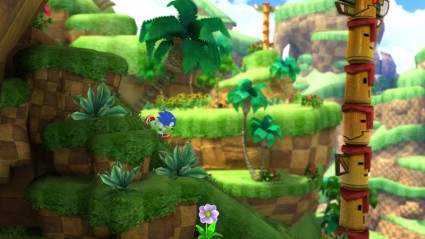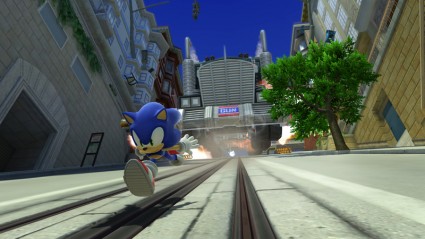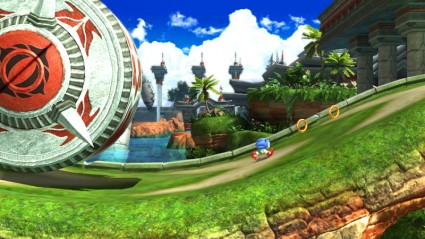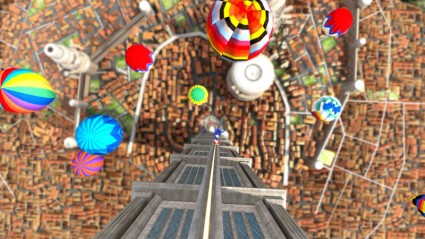Reviews
Review: Sonic Generations
October 31, 2011, Author: Diogo Miguel
It seems like ages since fans have begged Sega for high-definition ports of some of his early adventures. It did take Sega ages but the publisher finally caved in (to a certain extent) this year, with the arrival of Sonic’s twentieth year in the video-games industry. Sonic Generations is not your usual Sonic game, since all of the zones in it are remakes of those found in previous games.
Recent games might not have been in the hedgehog’s best interests, but there is no denying that people still have fond memories of the Mega Drive games. Is it enough, though, to call for development of a new game consisting of old Sonic levels, or is this another step in the wrong direction?
A hedgehog through the ages
At some point in their life, everyone will most likely wish they could go back in time, in order to have a chat with their past self. Fortunately for Sonic, this is pretty much what happens in his latest adventure. It’s his birthday, and the ever-growing group of friends he accumulated over the years have decided to surprise him with a party. A blue hedgehog’s job is never done, and he’s not even halfway through his birthday chilli dog when someone ruins the party. Sonic soon find himself alone as he helplessly watches his friends get sucked into a mysterious portal.
It’s common for a modern Sonic game to have a proper story, which is the case for Sonic Generations. The hedgehog finds himself in a bizarre place and soon starts exploring it. Sonic finds out that the déjà vu feeling he has experienced is actually the work of something sinister that threatens the very fabric of time. After meeting up with his 16-bit younger self, Sonic decides to get to the bottom of what is going on. It all sounds very complicated, but the game fortunately isn’t full of unnecessary cut scenes. With it being a story for a Sonic game, it’s not too hard to figure out what is going on either. Nevertheless, it is still amusing for the moments where modern versions of characters interact with their classic self.
The White Space is the main hub for the game and it’s where playable acts are found. Defeating a boss from one area will unlock new areas of the White Space hub. Some of the acts can only be reached by platforms spread across the White Space hub. The fact that everything is so close together in the hub means that players won’t have to waste time navigating menus.

A trip down memory lane.
Twice the fun
It’s been an uphill struggle for Sega when it comes to the modern Sonic games. Sonic didn’t take well to the third dimension, and it affected his games’ quality. Obviously, recent efforts like Sonic Unleashed and Sonic Colours managed to turn the tide of fortune. Sonic Generations offers two distinct ways to play, so it is only logical that the modern Sonic acts should take advantage of what worked in Sonic Colours and Sonic Unleashed.
The modern Sonic acts are all based on the concept of speed boosting. It doesn’t mean that an act is completed by merely using the speed boost, as it requires skill. The camera is not an issue any more, either. No longer will players suffer countless deaths due to awkward camera angles, like those found in Sonic Adventure. The acts themselves are carefully designed in such a manner that it is almost impossible to break up the game flow, due to a mix of well placed robots and level-specific gadgets. Acts get longer as the player progresses further into the game, but the regular checkpoints mean that there isn’t a lot of backtracking.
It’s expected, but classic Sonic acts are pretty much what Sonic fans have begged for years. This version of Sonic stays true to his roots and doesn’t have any extra abilities, besides the one exception in one of the last zones. The classic Sonic acts are platform-oriented like in the old Sonic games. The emphasis on multiple paths is extraordinary, with new routes being found with every new attempt at an act. In order to find specific paths players must act quickly, as it’s all about timing. The controls might feel odd at the beginning, due to the way that the spin dash works, but it’s easy to adjust.
It’s fantastic that Sonic Team have managed to merge two very distinct styles of play in one game. It’s incredible to see levels such as Sky Sanctuary remade with modern Sonic in mind, and classic Sonic running through the likes of a side scrolling Crisis City. What’s truly mind-blowing, though, is how these levels still work so well. Even level props like the truck in City Escape manage to successfully make the jump to the second dimension. It’s surprising, considering that this is the same development team that has struggled with basic concepts of design in modern Sonic games until recent years.
Each zone consists of one act for each of the Sonics to blaze through. Now, the game would be extremely short if it was just two acts for each zone. Fortunately, Sonic Team made sure that this wasn’t the case by adding mission acts. By completing the two main acts, players will add colour to the zone and unlock the missions. After doing the three zones, it is necessary to complete a set of missions, which will make it possible to collect a set of keys to unlock the boss act.
It seems like a chore, but missions have different goals. It’s actually worth the effort to play through them too. Some of them will simply ask players to achieve straightforward goals, like getting to the end of that mission. Others will include some of Sonic’s furry friends in friendly races and so on. It is a far more enjoyable way to slow down player progress than the way it’s done in some of Sonic’s previous adventures.
The chaos emeralds are in the game, but it’s not necessary to collect them from the traditional special stages. Instead Sonic Team have used a format similar to the PlayStation Portable Sonic Rivals titles, by pitting Sonic against rivals from his past. Some emeralds can also be earned by defeating the bosses, but it’s necessary to collect them as it’s part of the end game plot. Fortunately it’s not difficult to collect all of the emeralds, so it doesn’t ruin the game.
In fact, completing each mission will make it possible to unlock extras. These extras come in the form of floating iconic items such as a Mega Drive console, that the player must catch, after ringing a bell over the completed mission act gate. The extras can then be viewed in a museum to the far left, which is a nice way to let players see artwork and other media.
Something that doesn’t feel right in this new Sonic game is a skills shop found in the White Space hub. Sonic will be able to buy skills using skill points earned in acts, which will enable him to have certain new abilities such as recovering quickly when harmed by spikes. It’s even possible to combine various skills within one of the skill slots available. Fortunately it’s not an essential part of the game, so it will probably be ignored by most players. However, it’s often the case that some of the skills acquired might help make certain mission acts easier to complete. It’s probably for this reason that Sonic Team decided to aid players so that the game wouldn’t be criticized for being too challenging.
In fact, it’s easy to complete most of the game within a few hours. This is due to the superb level design that makes it difficult not to complete an act in the first attempt. The game also gives a score at the end of each act, but the real mission in this case is to get a poor grade. It seems that the developers thought players had a tough time on Sonic Colours and Sonic Unleashed, because the scores required for getting A and even S grades are fairly easy to obtain. Obviously it would be worse if the scoring system didn’t allow for no mistakes at all. It’s a good attempt at trying to even out the odds for less skilled players.
One of the best parts in Sonic games was to go up against the bosses. There’s no new bosses in Sonic Generations, save for the one exception that shall remain a mystery. This is not bad though, as it means that Sonic gets to defeat a lot of major bosses from his earlier adventures. The likes of Perfect Chaos and Metal Eggman 2 return to try to get rid of Sonic once and for all. The bosses have improved, though, and will attack Sonic with new attack patterns. It makes it far more interesting for those who defeated these bosses before, but it’s not overly difficult to defeat them. Fortunately, it is possible to face harder versions of the bosses after defeating them once.

Someone should tell Sonic that there is a speeding truck behind him.
Sorta like Green Hill, but with more dimensions
It goes without saying that the visuals in Sonic Generations are to die for. The classic levels look absolutely gorgeous with their high-definition makeovers. Not only that, but there’s been some subtle changes added in order to make levels even more appealing to look at. As usual, Sonic Team also added some subtle references to past games that should please Sonic fans. It’s important to note that both classic and modern Sonic acts are pretty much the same when it comes to the visuals. The use of colour has always been a popular element in Sonic games, and it’s one of the highlights in Sonic Generations. The vibrant colours of zones like Sky Sanctuary and Seaside Hill will surely bring back memories.
The level of detail that developers went to when designing the levels is impressive. Levels have backgrounds which manage to faithfully recreate pivotal moments of Sonic history, such as the Death Egg ascension in Sky Sanctuary. Sometimes it’s impossible to not stop and simply observe what’s going on in the background. Even the modern renditions of early Sonic levels and updated modern Sonic levels manage to capture this feeling of nostalgia.
It’s also possible to play the game in 3D, with the aid of 3D glasses and a TV that supports it. While it is a good sign that the industry is embracing the 3D movement, it doesn’t really add much to the game. Oddly enough, the 3D effects are less noticeable when playing through the game with modern Sonic. It’s the imposing scenery that pops up during classic Sonic levels that make the 3D effects more noticeable. Regardless, it’s not a game where the use of 3D adds to the experience.

Classic Sonic isn't having the best of times in Seaside Hill.
Has a nice ring to it
Perhaps one of the game’s biggest mysteries is how no one questions how classic Sonic can’t speak. It’s safe to say that dialogue has never been the best aspect of a modern Sonic game. Fortunately, dialogue is kept to a minimum in this game and it even manages to raise a smile on a few occasions. The decision to cast the vast group of friends Sonic accumulated over the years to a supporting role is wise. Each friend comes back to life when completing two main acts for each zone. However, they’ll only give generic advice when spoken to, as the main star of the show is Sonic.
Each of the zones has its own music tracks, so the likes of classic Green Hill and modern Rooftop Run get new music. It’s a real treat to listen to these music tracks, but it’s even better to listen to those created for levels that one of the Sonics didn’t originally go through. Remixes of tracks for classic levels like Crisis City and Rooftop Run are a credit to the game.
Sonic Team clearly went all out with this game, because it even made it possible to unlock extra music. It’s possible to use these extra music tracks when playing any of the levels. There are recent efforts like Splash Hill Zone from Sonic the Hedgehog 4 : Episode 1, and even more obscure music like the Toxic Caves music track from Sonic Spinball. The classic Sonic jingles are also back in updated forms, which should please many fans.

Those that are afraid of heights should look away now.
It took ages to be this good again
Sonic was already on the road to redemption with recent efforts like Sonic Unleashed and Sonic Colours. What Sonic Generations manages to accomplish, though, is proving the fact that Sonic still has a lot of untapped potential. This is not a new game in the traditional sense, but it’s impressive that Sonic Team managed to update levels from past games without messing anything up in the process. In fact, the levels manage to recreate the excitement that many felt when playing them for the first time, in their original forms.
It’s a shame that Sonic Generations ends far too quickly, but it makes up for it with quality level design and lots of small touches that will bring a smile to those playing it. This is the Sonic game that both old and new fans will be able to enjoy playing. Sonic’s birthday party might have got ruined, but it seems that it was worth it to create the best way to celebrate twenty years of Sonic gaming.
Platforms: PC, PS3, Xbox 360 | Tagged Eggman, Sega, Sonic, sonic generations, Sonic Team, Sonic the Hedgehog, Tails



